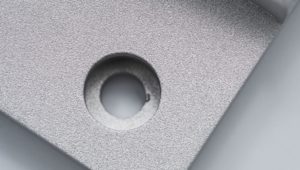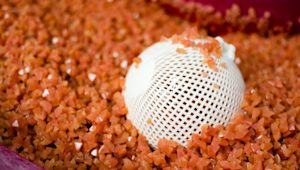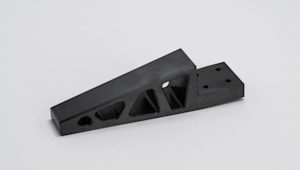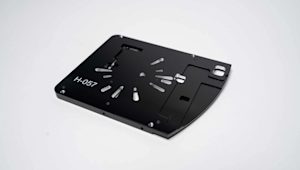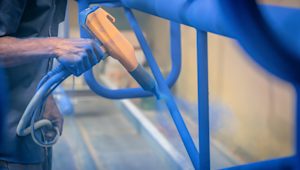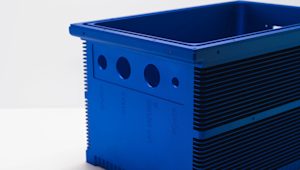Anodizing is an electrochemical process used to increase the thickness of the natural oxide layer on parts made of certain metals. It is a key step in manufacturing aluminum CNC machined parts, as it provides them with increased corrosion resistance and a more attractive finish. While anodizing is most common with aluminum, other metals can be anodized, including magnesium and titanium.
Protolabs Network offers Type II and Type III anodizing. Choosing the right anodizing type impacts a part’s surface hardness, corrosion resistance, aesthetics, and electrical insulation. These processes also help ensure optimal performance, longevity, and the cost-effectiveness of parts.
What is Type II anodizing?
Type II anodizing, also known as sulfuric acid anodizing, is an electrochemical process used to create an oxide layer on aluminum and its alloys. It involves immersing aluminum in a sulfuric acid electrolyte bath. When a direct current is applied to the bath, oxygen atoms combine with aluminum atoms on the part’s surface, forming an oxide layer.
What are the benefits of Type II anodizing?
Type II anodizing contributes to the overall performance, durability, and visual appeal of aluminum components. Its benefits include the following.
-
Improved corrosion resistance. Type II anodizing creates a protective oxide layer on an aluminum surface, significantly improving its resistance to corrosion. This makes it ideal for components exposed to mild-to-challenging environmental conditions.
-
Aesthetic finishes. Type II anodizing can produce aesthetically pleasing finishes in a range of colors, giving designers and manufacturers greater flexibility in achieving desired appearances. The anodized surface also maintains its color and appearance over time, unlike painted or coated surfaces.
Typical applications of Type II anodized parts
Type II anodized parts find applications in various industries due to their improved properties and aesthetic appeal. A few typical applications include the following.
-
Architectural. Type II anodized aluminum is used in building facades, windows, and doors for its corrosion resistance and attractive finishes.
-
Electronics. Type II anodized components are utilized in electronic devices for their electrical insulation and durability.
-
Automotive. Type II anodized parts in automotive applications include trim pieces, wheels, and engine components for their corrosion resistance, aesthetic finishes, and lightweight properties.
-
Aerospace. Type II anodizing is common in aerospace components to reduce weight and improve resistance to environmental factors.
-
Consumer goods. Type II anodized parts are found in products like cookware, sporting goods, and personal accessories due to their durability and color options.
-
Industrial equipment. Type II anodized components are used in machinery and equipment to extend their lifespan and protect against wear and corrosion.
What is Type III anodizing?
Type III anodizing, also known as hardcoat anodizing, is an electrochemical process that creates a thick and dense oxide layer on aluminum and its alloys. Type III anodizing works similarly to Type II, involving immersing aluminum in a sulfuric acid electrolyte bath. However, it uses lower temperatures and higher voltages, resulting in several benefits to parts.
What are the benefits of Type III anodizing?
Type III anodizing is a reliable surface treatment for critical components that must work under demanding conditions. These are some of its benefits.
-
Exceptional hardness and abrasion resistance. Type III anodizing produces a significantly thicker and denser oxide layer on aluminum than Type II anodizing, resulting in exceptional hardness and wear resistance, and making it suitable for components subjected to harsh mechanical conditions.
-
Enhanced dielectric properties. The thicker anodized layer in Type III anodizing provides excellent electrical insulation properties, making it beneficial for electronic components and applications requiring reliable dielectric performance.
-
Greater thermal shock resistance. Type III anodizing results in parts with greater thermal shock resistance than Type II anodizing. This means parts treated with Type III anodizing can endure substantial impacts from sound or other destructive factors without experiencing failure.
Typical applications of Type III anodized parts
Type III anodized parts serve well in applications where robustness, wear resistance, and temperature stability are vital. Common applications of Type III anodized parts include the following.
-
Aerospace. Type III anodizing is widely used for aircraft components such as landing gear, engine parts, and structural elements, as durability and resistance to harsh environments are crucial.
-
Industrial machinery. Critical parts in heavy machinery, such as pistons, cylinders, and gears, benefit from Type III anodizing for improved wear resistance and reliability.
-
Electronics. Electronic components, particularly in high-power applications, use Type III anodizing for its superior electrical insulation and thermal stability.
-
Automotive. High-performance automotive parts, like racing suspension components and engine parts, benefit from Type III anodizing to withstand extreme conditions.
-
Outdoor equipment. Camping gear, and bicycle components, among other outdoor equipment, use Type III anodizing for increased durability and corrosion resistance.
What are the differences between Type II and Type III anodizing?
Type II and Type III anodizing differ in several key aspects, leading to distinct properties and applications.
-
Anodizing process parameters. Type II anodizing involves sulfuric acid electrolyte and typically uses higher temperatures and lower voltages. Type III, on the other hand, employs the same sulfuric acid electrolyte, but uses lower temperatures and higher voltages, resulting in a thicker oxide layer on the part.
-
Coating thickness and properties. Type II anodizing produces a thinner oxide layer, providing scratch resistance and corrosion resistance. Type III anodizing yields a much thicker and denser oxide layer, resulting in improved hardness, abrasion resistance, and improved dielectric properties.
-
Surface finish and appearance. Type II anodizing can provide a range of aesthetically pleasing finishes with various color options. As Type III anodizing provides parts with a thicker coating, the results tend to be less uniform and will have a darker, more industrial appearance.
-
Material dimensions and tolerances. Type II anodizing generally adds a thin to moderate coating, causing minimal dimensional changes. Meanwhile, Type III anodizing’s thicker coating can lead to more significant dimensional changes, which may require adjustments in design and tolerances.
-
Cost. Type III anodizing is generally more expensive than Type II anodizing, as it requires lower temperatures and higher voltages. This results in a thicker and more time-consuming oxide layer formation, leading to increased production costs.
How to choose between Type II and Type III anodizing
Typically, Type II anodizing is preferred for decorative and moderate protection purposes, whereas Type III anodizing is suitable for applications demanding superior hardness, wear resistance, and electrically insulating properties. The choice between the two depends on the specific requirements of the intended application. To help you make that choice, you can refer to the following steps and tips.
-
Identify application requirements. Determine corrosion resistance, hardness, and wear resistance needed, as well as electrical insulation properties, if relevant.
-
Material compatibility. Ensure the base material is aluminum or an aluminum alloy, and consider any specific material characteristics.
-
Cost and production. Evaluate budget constraints, cost differences, and the impact on production timelines.
-
Environmental and regulatory concerns. Consider environmental impact and adherence to other regulations.
-
Consult an anodizing specialist. Seek advice from experts to make an informed decision based on technical aspects and benefits of each anodizing type.
Get an instant quote for anodized parts
To see Protolabs Network's competitive pricing and lead times for Type II and Type III anodized parts, upload a CAD file and start building your instant quote.
Deepen your understanding of post-processing and surface finishes and find out more about how anodizing works. You can also see a full list of the post-processing options available for CNC machined parts on the Protolabs Network platform.
Frequently asked questions
What is Type II anodizing?
Type II anodizing is regular sulfuric acid anodizing, creating a moderate oxide layer for improved corrosion resistance and aesthetic finishes.
What is Type III anodizing?
Type III anodizing is hardcoat sulfuric acid anodizing, forming a thicker, denser oxide layer for exceptional hardness and wear resistance.
When should you choose Type II anodizing?
Choose Type II for aesthetic finishes and corrosion resistance, without the need for extreme wear resistance.
When should you choose Type III anodizing?
Choose Type III for applications requiring superior hardness, abrasion resistance, electrical insulation and excellent thermal stability.
How does Type II anodizing differ from Type III?
Type II produces a thinner oxide layer, while Type III yields a thicker and more durable oxide layer.
What factors should I consider when choosing between Type II and Type III anodizing?
Consider application requirements, material compatibility, cost, production, environmental considerations. You can also consult with an anodizing specialist at Protolabs Network if you need any guidance.









